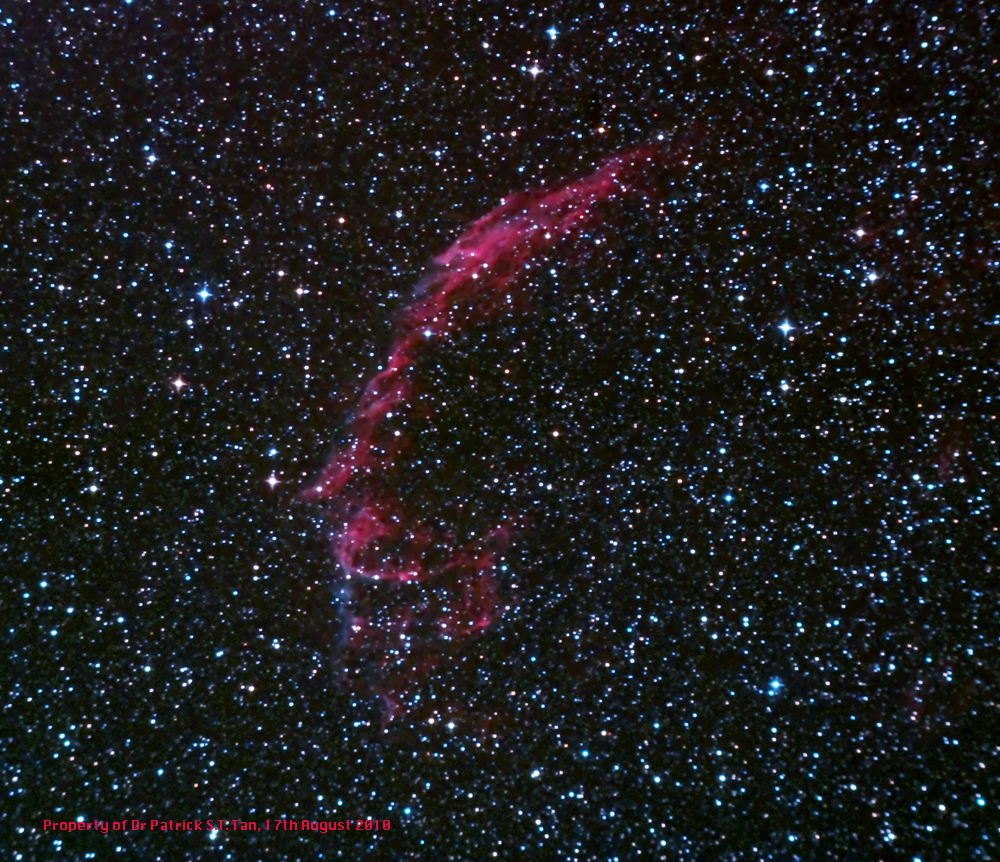
NGC 6992 (C33) : Eastern Veil Nebula
Date: 15/08/10 Time: 2300hrs Location: Sunningwell Temperature: 17.7ºC Relative Humidity: 67%
Camera: Nikon D80 Scope: William Optics Z66 Apo Doublet at prime focus Mount: piggy-backed on Meade LX90 in equatorial mode Filter: Astronomik CLS (LPF broadband filter) Exposures: 300+6(600) seconds ISO: 1600 F ratio: 5.9 Guidance: Autoguided
The Eastern Veil nebula, part of the Veil Nebula in Cygnus (the western and central portions of which were previously photographed by me and can be seen on the page entitled NGC 6960 ) is the brighter half of the entire nebula. It is a supernova remnant (SNR) - the fluorescing gaseous remains of a star which exploded about 15,000 years ago, and has expanded to occupy a patch of sky equivalent to the cumulative diameter of 36 full moons. (I know that I stated before, in the entries for NGC6960 that the age of the SNR was about 5000 years, but Stephen O' Meara's book on the Caldwell Objects gives us this much older age. It seems much more plausible since the supernova would have been the most prominent object in the night sky for many weeks, and 5000 years ago, one might have expected there to have been some ancient record of the event.) The type II supernova which gave rise to this beautiful nebula was the result of the explosion of a supergiant star - similar to Antares or Betelgeuse. Another famous type II supernova which has left us a SNR to look at, albeit with telescopes only, is the Crab Nebula M1, which exploded in 1054 AD leaving a visible object in the sky for weeks. The distance from us is as yet undetermined with any certainty but has been estimated at around 2500 light years. It was first observed in its entirety by William Herschel on the 5th of September, 1784.
This picture is the product of 7 viable exposures - one for 5 minutes and the other six, 10 minutes. The pictures were stacked in Maxim DL, and stretching (black and white point setting) and midtone enhancement was carried out as usual with Photoshop CS3. A single pass of Noise Ninja with luminance turned up to 14 and unsharp mask to 60% was applied prior to cropping. The H-alpha sensitive CCD of my modified Nikon caught the red, hydrogen fluorescence but the lighter blue nebulosity consisting of doubly ionised oxygen (OIII) is not as clearly seen as in composite photographs combining separate H-alpha and OIII filtered exposures. Nevertheless, the filamentary appearance and overall shape of the nebula are very apparent in this photo.
HOME PICTURES: Solar system PICTURES: Wide field